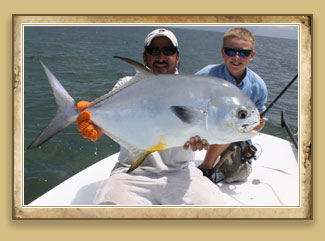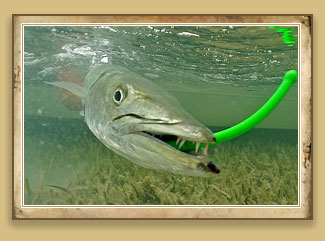|
|
|
|
The unique makeup of the Keys, which are composed or coral, create a surrounding area of pristine shallow water and mangrove islands where fish thrive. The fishing in the Keys is unparalleled to anywhere else in the world.
|
|
Fish to target
February - December: Permit
March - November: Bonefish
March - July: Tarpon - prime tarpon time (migration)
December - February: Barracuda
Year-round: Local tarpon
Year-round: Shark |
Tarpon
There is a reason why they are called the king of the flats. Few fish are more acrobatic or pull as hard, and with such endurance as a tarpon. In season, tarpon average from 80 - 150 pounds, with some over 200. Depending on the water temperature, they can be found in backcountry channels, flats, and around most bridges most of the year. Regardless, if you choose fly rods or conventional tackle with live bait, these bruisers will challenge all of your angling skills. I also offer tarpon night trips as night is also a great time to tarpon fish.
|
 |
Permit
The permit is a very strong and hard fighting fish, averaging 8-40 pounds. They tolerate both slightly cooler, and warmer conditions than bonefish do. They are also year-round, with February - November typically being the most productive. The permit's favorite food are crabs. Fly fisherman use a variety of crab fly patterns. With conventional tackle, you cannot beat a live crab. While permit can be easy to fool while fishing over a deep wreck, when the permit on are the flats, they are quite possibly the ultimate fly fisherman's challenge. The permit fishing in the lower Keys is arguable the best in the world, including the areas around Cudjoe Key, Summerland Key, Sugarloaf Key, Big Pine Key and Key West.
|
 |
Bonefish
They don't call them the grey ghosts of the flats for nothing. They can appear out of nowhere, and leave just as fast, making them a serious challenge for the most seasoned angler. Their willingness to take flies makes them one of the most sought-after fish in the world. Even while using conventional tackle with live shrimp, they are quite challenging, and require a perfect cast. You must be disciplined, always alert, and scanning the water for their presence. This is sight-fishing at the highest level, but your reward will far exceed your effort. Bonefish are lightening quick and their long powerful runs will not disappoint you. We catch them year round, but cold fronts will chase them off the flats in the winter. Most fish average from 2-14 pounds.
|
 |
Barracuda
Without question, barracuda are the most underrated fish on the
flats. When cold fronts chase other fish from the flats, barracuda
flood them. They love flies and lures not to mention live bait, and
their ferocious strike will often make your hands and knees shake.
They often jump and make long runs. What else could you ask for?
In the winter, we often target them and average up to 20 fish a day
in the 10 - 30 lb. range. They are great for beginners since they are not as spooky as other fish, and they are a lot of fun no matter what your skill level. On flat calm days, barracudas get spooked easier and can be as challenging as the big 3.
|
 |
Shark
Most people don't associate sharks with flats fishing, but rarely
does a day go by that I don't see a few on the flats. We typically target other fish, but I always have a shark rod rigged up and ready to go in case one crosses our path. You can catch them on flies, lures and of course live and dead bait. The most common sharks encountered are: black tips, lemons, bonnetheads, bulls, nurse sharks and spinners.
|
 |
| |
 |
|
|
|
 |
|